

History of Psychopharmacology. Muscarine. Muscarine, L-(+)-muscarine, or muscarin is a natural product found in certain mushrooms, particularly in Inocybe and Clitocybe species, such as the deadly C. dealbata.

Mushrooms in the genera Entoloma and Mycena have also been found to contain levels of muscarine which can be dangerous if ingested. Muscarine has been found in harmless trace amounts in Boletus, Hygrocybe, Lactarius and Russula. Muscarine is only a trace compound in the fly agaric Amanita muscaria; the pharmacologically more relevant compound from this mushroom is muscimol. A. muscaria fruitbodies contain a variable dose of muscarine, usually around 0.0003% fresh weight.
This is very low and toxicity symptoms occur very rarely. Muscarine is a nonselective agonist of the muscarinic acetylcholine receptor. Hallucinogen. A hallucinogen is a psychoactive agent which can cause hallucinations, perception anomalies, and other substantial subjective changes in thoughts, emotion, and consciousness.The common types of hallucinogens are psychedelics, dissociatives, or deliriants.
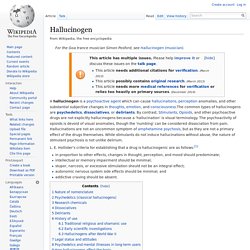
By contrast, Stimulants, Opioids, and other psychoactive drugs are not explicitly hallucinogens because a 'hallucination' is visual terminology. The psychoactivity of opioids is devoid of visual anomalies, though the 'numbing' can be considered dissociation from pain. Hallucinations are not an uncommon symptom of amphetamine psychosis, but as they are not a primary effect of the drugs themselves. While stimulants do not induce hallucinations without abuse, the nature of stimulant psychosis is not unlike delirium.
L. Mescaline. Mescaline or 3,4,5-trimethoxyphenethylamine is a naturally occurring psychedelic alkaloid of the phenethylamine class, known for its hallucinogenic effects similar to those of LSD and psilocybin.
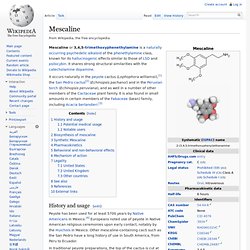
It shares strong structural similarities with the catecholamine dopamine. It occurs naturally in the peyote cactus (Lophophora williamsii),[1] the San Pedro cactus[2] (Echinopsis pachanoi) and in the Peruvian torch (Echinopsis peruviana), and as well in a number of other members of the Cactaceae plant family. It is also found in small amounts in certain members of the Fabaceae (bean) family, including Acacia berlandieri.[3] Naturally derived mescaline powder extract. History and usage[edit] Peyote has been used for at least 5700 years by Native Americans in Mexico.[4] Europeans noted use of peyote in Native American religious ceremonies upon early contact, notably by the Huichols in Mexico. Potential medical usage[edit] Psilocybin. Psilocybin[nb 1] (/ˌsɪləˈsaɪbɪn/ SIL-ə-SY-bin) is a naturally occurring psychedelic compound produced by more than 200 species of mushrooms, collectively known as psilocybin mushrooms.
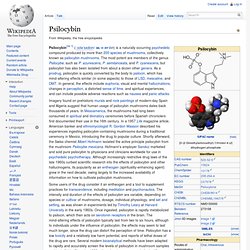
Muscimol. Muscimol (agarin, pantherine) is the major psychoactive alkaloid present in many mushrooms of the Amanita genus. Muscimol is a potent, selective agonist for the GABAA receptors and displays sedative-hypnotic effects. Chemistry[edit] Muscimol is the psychoactive compound responsible for the effects of Amanita muscaria intoxication.
Opium. Opium ( poppy tears , lachryma papaveris ) is the dried latex obtained from the opium poppy ( Papaver somniferum ).

Opium contains approximately 12% morphine , an alkaloid , which is frequently processed chemically to produce heroin for the illegal drug trade . The latex also includes codeine and non-narcotic alkaloids such as papaverine , thebaine and noscapine . Neolithic. The Neolithic (/ˌniːəˈlɪθɪk/ (
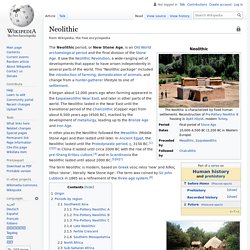
Tribe. There are an estimated one hundred and fifty million tribal individuals worldwide,[2] constituting around forty percent of indigenous individuals.
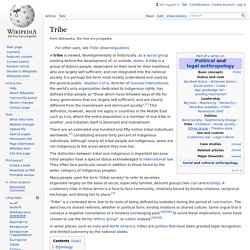
Although nearly all tribal people are indigenous, some are not indigenous to the areas where they now live. The distinction between tribal and indigenous is important because tribal peoples have a special status acknowledged in international law. They often face particular issues in addition to those faced by the wider category of indigenous peoples.
Cannabis. Cannabis ( / ˈ k æ n ə b ɪ s / ; Cán-na-bis ) is a genus of flowering plants that includes three putative varieties, Cannabis sativa , [ 1 ] Cannabis indica , [ 1 ] and Cannabis ruderalis .
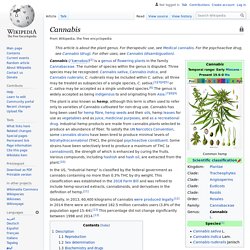
These three taxa are indigenous to Central Asia , and South Asia . [ 2 ] Cannabis has long been used for fibre ( hemp ), for seed and seed oils, for medicinal purposes , and as a recreational drug . Industrial hemp products are made from Cannabis plants selected to produce an abundance of fiber. To satisfy the UN Narcotics Convention , some Cannabis strains have been bred to produce minimal levels of THC , the principal psychoactive constituent responsible for the "high" associated with marijuana . Marijuana consists of the dried flowers of Cannabis plants selectively bred to produce high levels of THC and other psychoactive cannabinoids . Various extracts including hashish and hash oil are also produced from the plant. [ 3 ] Etymology Description.
Traditional Chinese medicine. Traditional Chinese medicine (TCM; simplified Chinese: 中医; traditional Chinese: 中醫; pinyin: zhōng yī; literally "Chinese medicine") is a broad range of medicine practices sharing common concepts which have been developed in China and are based on a tradition of more than 2,000 years, including various forms of herbal medicine, acupuncture, massage (Tui na), exercise (qigong), and dietary therapy.[1] The doctrines of Chinese medicine are rooted in books such as the Yellow Emperor's Inner Canon and the Treatise on Cold Damage, as well as in cosmological notions such as yin-yang and the five phases.

St John's wort. St John's wort (traditionally / ˈ s ɪ n dʒ ə n z w ɜr t / SIN -jənz-wurt ; now / w ɔr t / in some dialects) is the plant species Hypericum perforatum , and is also known as Tipton's weed , rosin rose , goatweed , chase-devil , or Klamath weed . [ 1 ] With qualifiers, St John's wort is used to refer to any species of the genus Hypericum .
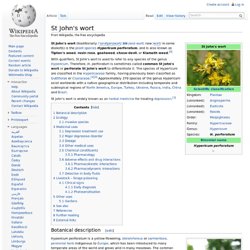
Therefore, H. perforatum is sometimes called common St John's wort or perforate St John's wort to differentiate it. The species of Hypericum are classified in the Hypericaceae family, having previously been classified as Guttiferae or Clusiaceae . [ 2 ] [ 3 ] Approximately 370 species of the genus Hypericum exist worldwide with a native geographical distribution including temperate and subtropical regions of North America , Europe , Turkey , Ukraine , Russia , India , China and Brazil .
St John's wort is widely known as an herbal medicine for treating depression . [ 1 ] Botanical description [ edit ] Translucent dots on the leaves. Ethnobotany. Ethnobotany is the study of a region's plants and their practical uses through the traditional knowledge of a local culture and people.[1] An ethnobotanist thus strives to document the local customs involving the practical uses of local flora for many aspects of life, such as plants as medicines, foods, and clothing.[2] Richard Evans Schultes, often referred to as the "father of ethnobotany",[3] explained the discipline in this way: Ethnobotany simply means ... investigating plants used by primitive societies in various parts of the world.[4] Since the time of Schultes, the field of ethnobotany has grown from simply acquiring ethnobotanical knowledge to that of applying it to a modern society, primarily in the form of pharmaceuticals.[5] Intellectual property rights and benefit-sharing arrangements are important issues in ethnobotany.[6] History[edit] Medieval and Renaissance[edit] During the medieval period, ethnobotanical studies were commonly found connected with monasticism.
Ethnomycology. Ethnomycology is the study of the historical uses and sociological impact of fungi and can be considered a subfield of ethnobotany or ethnobiology. Although in theory the term includes fungi used for such purposes as tinder, medicine (medicinal mushrooms) and food (including yeast), it is often used in the context of the study of psychoactive mushrooms such as psilocybin mushrooms, the Amanita muscaria mushroom, and the ergot fungus. American banker Robert Gordon Wasson pioneered interest in this field of study in the late 1950s, when he and his wife became the first Westerners on record allowed to participate in a mushroom velada, held by the Mazatec curandera María Sabina. The biologist Richard Evans Schultes is also considered an ethnomycological pioneer.